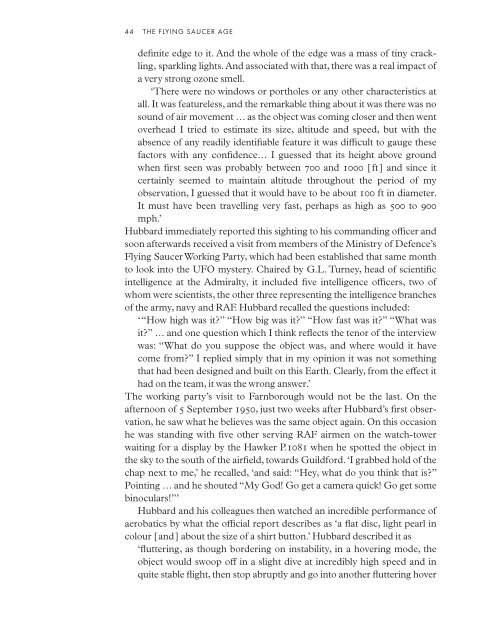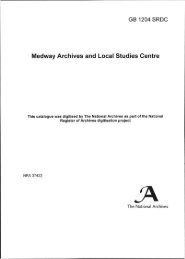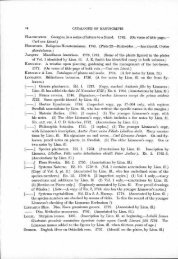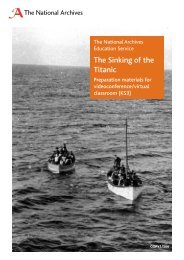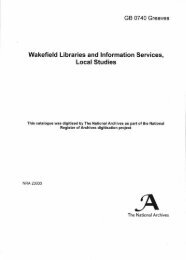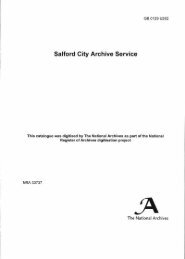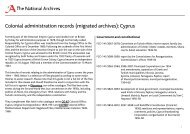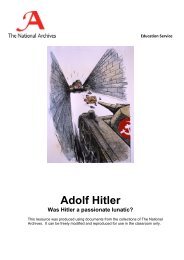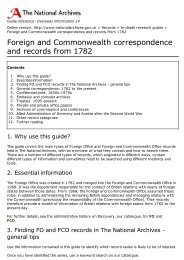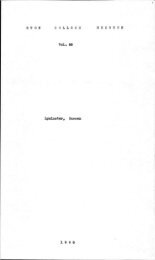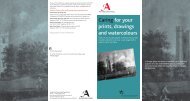THE UFO FILES - The National Archives
THE UFO FILES - The National Archives
THE UFO FILES - The National Archives
Create successful ePaper yourself
Turn your PDF publications into a flip-book with our unique Google optimized e-Paper software.
44 <strong>THE</strong> FLYING SAUCER AGE<br />
definite edge to it. And the whole of the edge was a mass of tiny crackling,<br />
sparkling lights. And associated with that, there was a real impact of<br />
a very strong ozone smell.<br />
‘<strong>The</strong>re were no windows or portholes or any other characteristics at<br />
all. It was featureless, and the remarkable thing about it was there was no<br />
sound of air movement … as the object was coming closer and then went<br />
overhead I tried to estimate its size, altitude and speed, but with the<br />
absence of any readily identifiable feature it was difficult to gauge these<br />
factors with any confidence… I guessed that its height above ground<br />
when first seen was probably between 700 and 1000 [ ft ] and since it<br />
certainly seemed to maintain altitude throughout the period of my<br />
observation, I guessed that it would have to be about 100 ft in diameter.<br />
It must have been travelling very fast, perhaps as high as 500 to 900<br />
mph.’<br />
Hubbard immediately reported this sighting to his commanding officer and<br />
soon afterwards received a visit from members of the Ministry of Defence’s<br />
Flying Saucer Working Party, which had been established that same month<br />
to look into the <strong>UFO</strong> mystery. Chaired by G.L. Turney, head of scientific<br />
intelligence at the Admiralty, it included five intelligence officers, two of<br />
whom were scientists, the other three representing the intelligence branches<br />
of the army, navy and RAF. Hubbard recalled the questions included:<br />
‘“How high was it?” “How big was it?” “How fast was it?” “What was<br />
it?” … and one question which I think reflects the tenor of the interview<br />
was: “What do you suppose the object was, and where would it have<br />
come from?” I replied simply that in my opinion it was not something<br />
that had been designed and built on this Earth. Clearly, from the effect it<br />
had on the team, it was the wrong answer.’<br />
<strong>The</strong> working party’s visit to Farnborough would not be the last. On the<br />
afternoon of 5 September 1950, just two weeks after Hubbard’s first observation,<br />
he saw what he believes was the same object again. On this occasion<br />
he was standing with five other serving RAF airmen on the watch-tower<br />
waiting for a display by the Hawker P.1081 when he spotted the object in<br />
the sky to the south of the airfield, towards Guildford. ‘I grabbed hold of the<br />
chap next to me,’ he recalled, ‘and said: “Hey, what do you think that is?”<br />
Pointing … and he shouted “My God! Go get a camera quick! Go get some<br />
binoculars!”’<br />
Hubbard and his colleagues then watched an incredible performance of<br />
aerobatics by what the official report describes as ‘a flat disc, light pearl in<br />
colour [ and ] about the size of a shirt button.’ Hubbard described it as<br />
‘fluttering, as though bordering on instability, in a hovering mode, the<br />
object would swoop off in a slight dive at incredibly high speed and in<br />
quite stable flight, then stop abruptly and go into another fluttering hover


